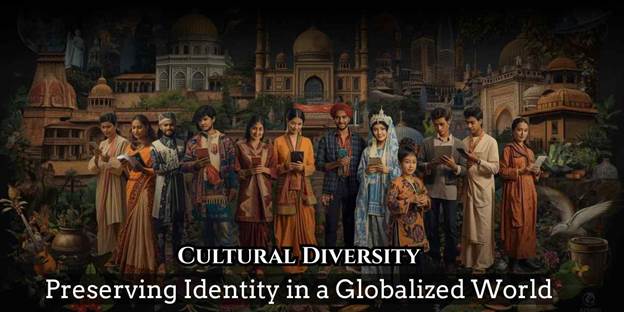In today’s interconnected world, cultural diversity stands as one of humanity’s greatest strengths. It reflects the rich mosaic of traditions, languages, and beliefs that define who we are. However, as globalization accelerates, preserving this diversity has become both a challenge and a necessity. The influence of modern media, technology, and global markets has blurred the boundaries between cultures, creating a complex balance between innovation and identity.
Table of Contents
This article explores the meaning of cultural diversity, its connection with heritage, the importance of preserving identity in modern society, and how individuals and nations can protect their cultural roots while embracing progress.

Understanding Cultural Diversity and Its Meaning
(Cultural Diversity: 7 Powerful Insights into Human Connection and Identity)
Cultural diversity refers to the variety of cultures that exist within a society or across the globe. It encompasses languages, traditions, arts, cuisines, values, and ways of life. Diversity is what makes societies vibrant and adaptable. It shapes our creativity, our relationships, and the way we perceive the world.
In a globalized context, cultural diversity encourages mutual understanding and respect. When people from different backgrounds interact, they exchange ideas that lead to innovation, empathy, and peace. It’s not just about preserving traditions it’s about celebrating the collective wisdom of humanity.
The Historical Roots of Cultural Diversity
(Cultural Diversity: 6 Inspiring Lessons from History and Global Exchange)
Throughout history, cultural diversity has evolved through migration, trade, and exploration. Ancient civilizations such as Egypt, Greece, China, and India thrived because they embraced cultural exchange. The Silk Road, for example, was not just a trade route but a bridge connecting languages, arts, and religions.
However, the industrial and colonial eras altered this natural exchange, sometimes suppressing indigenous cultures and promoting uniformity. Today, globalization mirrors this duality it connects people while also posing the risk of cultural homogenization. Understanding this history helps us recognize why protecting cultural identity in modern society is essential for balance and sustainability.
The Importance of Cultural Heritage in Modern Society
( Cultural Diversity: 8 Positive Reasons Heritage Matters in Modern Life)
Cultural heritage is the foundation of cultural diversity. It includes tangible artifacts like monuments and intangible expressions such as folklore, music, and rituals. In a rapidly changing world, heritage anchors societies to their roots, offering continuity and identity.
Preserving cultural heritage in modern society helps:
•Maintain social cohesion and shared values
•Promote intergenerational learning and pride
•Inspire creativity through traditional knowledge
•Encourage inclusivity and cross-cultural respect
By celebrating heritage, societies don’t reject modernity they enhance it with wisdom drawn from their past.
Globalization and the Threat to Cultural Identity
( Cultural Diversity: 5 Real Challenges Globalization Brings to Identity)
While globalization promotes progress, it also challenges cultural diversity. The global media and entertainment industries often favor dominant cultures, pushing local customs into the background. As a result, smaller communities struggle to maintain their traditions.
Major threats include:
•Language extinction due to urban migration
•Commercialization of cultural symbols without context
•Adoption of uniform lifestyles and consumer behavior
•Loss of indigenous art forms and rituals
When global trends overshadow local heritage, societies risk losing their unique identities. Balancing modern development with cultural preservation has therefore become an urgent global concern.
The Benefits of Embracing Cultural Diversity
( Cultural Diversity: 9 Authentic Benefits That Strengthen Society)
When societies embrace cultural diversity, they gain immense social and economic benefits. Diversity fosters creativity, enhances problem-solving, and builds tolerance among citizens.
Key benefits include:
- Innovation and Creativity: Diverse perspectives lead to new ideas.
- Social Cohesion: Shared respect builds stronger communities.
- Economic Growth: Multicultural environments attract global talent.
- Cultural Diplomacy: Promoting diversity improves international relations.
- Sustainability: Traditional ecological knowledge contributes to environmental preservation.
Cultural diversity, therefore, is not a barrier to progress it’s a catalyst for a balanced and inclusive future.

Education: The Cornerstone of Cultural Preservation
( Cultural Diversity: 7 Transformative Ways Education Sustains Identity)
Education plays a vital role in maintaining cultural diversity. Schools and universities are platforms where students can learn to appreciate multiple perspectives. Multicultural education helps young people understand that respecting others’ traditions does not diminish their own.
Effective strategies include:
•Including local history, literature, and languages in curricula
•Encouraging cultural exchange programs
•Promoting arts, crafts, and folklore in classrooms
•Using digital platforms to document and share heritage
By making cultural education accessible and engaging, societies can ensure the next generation values diversity as an essential part of identity.
Real-World Examples of Preserving Cultural Diversity
( Cultural Diversity: 6 Inspiring Global Success Stories of Heritage Preservation)
Across the world, communities and governments are taking bold steps to preserve cultural diversity:
•Japan: Protects intangible heritage such as calligraphy and tea ceremonies under national law.
•Peru: Revives indigenous Quechua language programs in schools.
•France: Maintains regional traditions like Breton and Basque festivals.
•UNESCO: Safeguards global heritage sites and cultural practices to promote diversity.
•India: Celebrates unity in diversity through festivals like Diwali, Eid, and Christmas with equal respect.
These examples prove that cultural preservation can thrive alongside modernization when supported by awareness, policy, and education.
Technology and Global Awareness in Cultural Preservation
( Cultural Diversity: 5 Powerful Ways Technology Protects Heritage Today)
Technology can either harm or help cultural diversity, depending on how it’s used. While social media sometimes spreads stereotypes, it can also become a powerful tool for cultural renewal. Digital platforms now allow communities to document their traditions, record oral histories, and promote awareness on a global scale.
From virtual museums to cultural podcasts and global collaborations, the internet has become a bridge connecting people with different traditions. When technology is guided by respect and education, it ensures that diversity continues to flourish in the digital age.
Building a Future Rooted in Cultural Diversity
( Cultural Diversity: 5 Positive Predictions for the Future of Human Identity)
The future of modern society depends on its ability to value and sustain cultural diversity. Governments, educators, and communities must collaborate to protect both tangible and intangible heritage. By promoting cultural exchange, investing in heritage conservation, and supporting inclusive education, humanity can ensure that globalization becomes a bridge not a barrier to identity.
A world that respects and celebrates its differences will not only survive change but thrive through it.
Conclusion: Preserving Our Shared Identity
In a globalized world, cultural diversity remains the heartbeat of human civilization. It connects us to our roots, strengthens communities, and nurtures empathy across borders. By valuing heritage while embracing progress, societies can create a world that celebrates both individuality and unity. Let us continue to learn, share, and preserve the colors of culture that make humanity truly extraordinary.